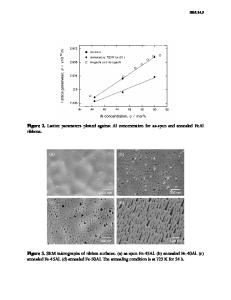Slip Directions in B2 Fe-Al Alloys
- PDF / 2,599,414 Bytes
- 5 Pages / 594 x 774 pts Page_size
- 86 Downloads / 382 Views
REFERENCES
Fig. 4--Transmission electron micrograph in the 300 ~ tempered condition showing grain boundary carbides.
critical test temperature. Below the critical test temperature, without grain boundary carbides, the matrix toughness may be probably low enough to produce the transgranular fracture. In other words, the crack cannot preferentially propagate along the grain boundaries without the grain boundary carbides. On the other hand, in the 300 ~ tempered condition, the grain boundaries can act as the easy fracture path due to the presence of grain boundary carbides. However, grain boundary carbides alone may not make grain boundaries the easy fracture path unless the impurities were present at the grain boundaries. Briant and Banerji5 reported that the impurity segregation at the grain boundaries was observed in high purity Ni-Cr steel (0.004 P, 0.004 S) and it could produce the intergranular TME. The impurity segregation may occur also in the relatively high purity Ni-steel investigated in this study although its extent may be small. Thus, in the 300 ~ tempered condition, the grain boundaries may act as the easy fracture path by the combined action of carbides and impurities at the grain boundaries. Below the critical test temperature, the presence of the cementite platelets at the impurity-weakened grain boundaries lowers the brittle fracture energy and increases the extent of intergranular fracture. For the relatively high purity steel, the impurity segregation at the grain boundaries may be small. 5 In a nonembrittled condition (200 ~ tempered condition), the grain boundaries alone without carbides do not become weak even below the critical test temperature. Thus, the impact energy does not correlate with the amount of intergranular fracture. In an embrittled condition (300 ~ tempered condition), the grain boundaries with carbides become weak below the critical test temperature. The grain boundaries act as the easy fracture path, so the amount of intergranular fracture increases with decreasing test temperature. Also, the impact energy correlates very well with the amount of intergranular fracture. It is believed that for the intergranular TME, the contribution of cementite platelets at the grain boundaries to the intergranular fracture in the relatively high purity steel may be larger than that in commercial purity steel. It is clear from this study on the relatively high purity steel that the presence of grain boundary carbides is necessary to METALLURGICALTRANSACTIONS A
1. J. McMahon andG. Thomas:Proc. Third lnternationaI Conference on Strength of Metals andAlloys, Inst. of Metals, London, 1973, vol. 1, p. 180. 2. G. Thomas: Metall. Trans. A, 1978, vol. 9A, p. 439. 3. B.V.N. Rao and G. Thomas: Metall. Trans. A, 1980, vol. llA, p. 441. 4. H. Kwon and C. H. Kim: MetaU. Trans. A, 1983, vot. 14A, p. 1389. 5. C.L. Briant and S.K. Banerji: Metall. Trans. A, 1979, vol. 10A, p. 1151. 6. S.K. Banerji, C. J. McMahon, Jr., and H. C. Feng: Metall. Trans. A, 1978, vol. 9A, p. 237. 7. H. Kwon and C. H. Kim: J. Mat
Data Loading...











